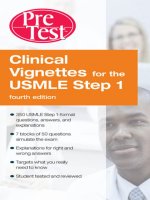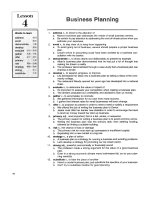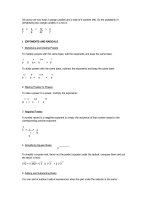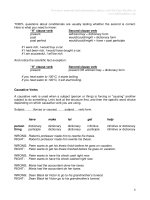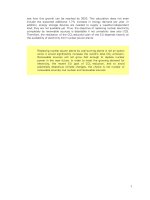First Aid Cases for the USMLE Step 2 CK, -McGraw-Hill Medical (2009)
Bạn đang xem bản rút gọn của tài liệu. Xem và tải ngay bản đầy đủ của tài liệu tại đây (5.16 MB, 577 trang )
FIRST AID
™
CASES FOR THE
USMLE
STEP 2 CK
Second Edition
TAO LE, MD, MHS
Assistant Clinical Professor of Pediatrics and Medicine
Division of Allergy and Clinical Immunology
Department of Pediatrics
University of Louisville
ELIZABETH EBY HALVORSON, MD
Vanderbilt School of Medicine
Class of 2009
Resident
Department of Pediatrics
Wake Forest University Baptist Medical Center
New York / Chicago / San Francisco / Lisbon / London / Madrid / Mexico City
Milan / New Delhi / San Juan / Seoul / Singapore / Sydney / Toronto
Copyright © 2010, 2007 by Tao Le. All rights reserved. Except as permitted under the United States Copyright Act of 1976, no part of this publication may be reproduced or distributed in any form or by any means, or stored in a database or retrieval system, without the prior written permission of the publisher.
ISBN: 978-0-07-162926-3
MHID: 0-07-162926-2
The material in this eBook also appears in the print version of this title: ISBN: 978-0-07-162570-8, MHID: 0-07-162570-4.
All trademarks are trademarks of their respective owners. Rather than put a trademark symbol after every occurrence of a trademarked name, we use names in an
editorial fashion only, and to the benefit of the trademark owner, with no intention of infringement of the trademark. Where such designations appear in this book, they
have been printed with initial caps.
McGraw-Hill eBooks are available at special quantity discounts to use as premiums and sales promotions, or for use in corporate training programs. To contact a
representative please e-mail us at
Medicine is an ever-changing science. As new research and clinical experience broaden our knowledge, changes in treatment and drug therapy are required. The authors
and the publisher of this work have checked with sources believed to be reliable in their efforts to provide information that is complete and generally in accord with
the standards accepted at the time of publication. However, in view of the possibility of human error or changes in medical sciences, neither the authors nor the publisher nor any other party who has been involved in the preparation or publication of this work warrants that the information contained herein is in every respect accurate or complete, and they disclaim all responsibility for any errors or omissions or for the results obtained from use of the information contained in this work. Readers
are encouraged to conform the information contained herein with other sources. For example and in particular, readers are advised to check the product information
sheet included in the package of each drug they plan to administer to be certain that the information contained in this work is accurate and that changes have not been
made in the recommended dose or in the contraindications for administration. This recommendation is of particular importance in connection with new or infrequently used drugs.
TERMS OF USE
This is a copyrighted work and The McGraw-Hill Companies, Inc. (“McGraw-Hill”) and its licensors reserve all rights in and to the work. Use of this work is subject
to these terms. Except as permitted under the Copyright Act of 1976 and the right to store and retrieve one copy of the work, you may not decompile, disassemble,
reverse engineer, reproduce, modify, create derivative works based upon, transmit, distribute, disseminate, sell, publish or sublicense the work or any part of it without
McGraw-Hill’s prior consent. You may use the work for your own noncommercial and personal use; any other use of the work is strictly prohibited. Your right to use
the work may be terminated if you fail to comply with these terms.
THE WORK IS PROVIDED “AS IS.” McGRAW-HILL AND ITS LICENSORS MAKE NO GUARANTEES OR WARRANTIES AS TO THE ACCURACY, ADEQUACY OR COMPLETENESS OF OR RESULTS TO BE OBTAINED FROM USING THE WORK, INCLUDING ANY INFORMATION THAT CAN BE
ACCESSED THROUGH THE WORK VIA HYPERLINK OR OTHERWISE, AND EXPRESSLY DISCLAIM ANY WARRANTY, EXPRESS OR IMPLIED,
INCLUDING BUT NOT LIMITED TO IMPLIED WARRANTIES OF MERCHANTABILITY OR FITNESS FOR A PARTICULAR PURPOSE. McGraw-Hill and
its licensors do not warrant or guarantee that the functions contained in the work will meet your requirements or that its operation will be uninterrupted or error free.
Neither McGraw-Hill nor its licensors shall be liable to you or anyone else for any inaccuracy, error or omission, regardless of cause, in the work or for any damages
resulting therefrom. McGraw-Hill has no responsibility for the content of any information accessed through the work. Under no circumstances shall McGraw-Hill
and/or its licensors be liable for any indirect, incidental, special, punitive, consequential or similar damages that result from the use of or inability to use the work, even
if any of them has been advised of the possibility of such damages. This limitation of liability shall apply to any claim or cause whatsoever whether such claim or cause
arises in contract, tort or otherwise.
D E D I C AT I O N
To the contributors to this and future editions, who took time to share their
knowledge, insight, and humor for the benefit of all those who yearn to pass
their boards.
and
To our families, friends, and loved ones, who encouraged and assisted us in
the task of assembling this guide.
This page intentionally left blank
CONTENTS
Contributing Authors
xv
Senior Reviewers
xvii
Preface
xix
Acknowledgments
xxi
How to Contribute
xxiii
Cardiology
1
Case 1: Abdominal Aortic Aneurysm
2
Case 2: Acute Cardiogenic Pulmonary Edema
3
Case 3: Acute Coronary Syndrome
4
Case 4: Aortic Dissection
6
Case 5: Acute Myocardial Infarction—Long-Term Management
8
Case 6: Aortic Regurgitation
9
Case 7: Atrial Fibrillation
10
Case 8: Cardiac Tamponade
12
Case 9: Congestive Heart Failure
14
Case 10: Deep Venous Thrombosis
16
Case 11: Dilated Cardiomyopathy (Alcoholic)
18
Case 12: Diastolic Heart Failure
20
Case 13: Aortic Stenosis
21
Case 14: Hypercholesterolemia
22
Case 15: Hypertension—Essential
23
Case 16: Hypertension—Renal Artery Stenosis
24
Case 17: Hypertrophic Obstructive Cardiomyopathy
26
Case 18: Infective Endocarditis
28
Case 19: Myocardial Infarction
30
Case 20: Papillary Muscle Rupture
32
Case 21: Pericarditis
34
Case 22: Peripheral Vascular Disease
36
Case 23: Mitral Regurgitation
37
Case 24: Second-Degree Heart Block
38
Case 25: Wolff-Parkinson-White Syndrome
40
Dermatology
43
Case 1: Acanthosis Nigricans
44
Case 2: Acne Vulgaris
46
Case 3: Atopic Dermatitis
47
v
Case 4: Basal Cell Carcinoma
48
Case 5: Bullous Pemphigoid
50
Case 6: Herpes Simplex
51
Case 7: Hidradenitis Suppurativa
52
Case 8: Kaposi Sarcoma
53
Case 9: Lichen Planus
54
Case 10: Molluscum Contagiosum
56
Case 11: Pemphigus
58
Case 12: Pityriasis Rosea
60
Case 13: Psoriasis
62
Case 14: Stevens-Johnson Syndrome
64
Case 15: Varicella-Zoster Virus
66
Case 16: Tuberous Sclerosis
68
Case 17: Onychomycosis
69
Case 18: Melanoma
70
Endocrinology
Case 1: Acromegaly
72
Case 2: Cushing’s Syndrome
74
Case 3: Adrenal Insufficiency (Addison’s Disease)
76
Case 4: Diabetes Insipidus
77
Case 5: Diabetes Mellitus, Type 1
78
Case 6: Diabetic Ketoacidosis
79
Case 7: Hyperthyroidism (Graves’ Disease)
80
Case 8: Hypokalemia (Hyperaldosteronism)
82
Case 9: Hyperparathyroidism
84
Case 10: Hypothyroidism (Hashimoto’s Thyroiditis)
85
Case 11: Multiple Endocrine Neoplasia, Type I
86
Case 12: Metabolic Syndrome
88
Case 13: Multiple Endocrine Neoplasia, Type II
89
Case 14: Osteoporosis
90
Case 15: Paget’s Disease of Bone
92
Case 16: Pheochromocytoma
94
Case 17: Syndrome of Inappropriate Antidiuretic Hormone Secretion
96
Case 18: Thyroid Nodule
98
Case 19: Subacute Granulomatous Thyroiditis (de Quervain’s Thyroiditis)
Epidemiology and Preventive Medicine
vi
71
100
101
Case 1: Bias and Confounding
102
Case 2: Bioterrorism
104
Case 3: Breast Cancer Screening
106
Case 4: Cohort Studies
108
Case 5: Health Care Screening
109
Case 6: Incidence and Prevalence
110
Case 7: Influenza Vaccine
112
Case 8: Obesity Effects on Health
114
Case 9: Randomized Clinical Trial
116
Case 10: Sensitivity and Specificity
118
Case 11: Reliability and Validity
120
Case 12: Positive Predictive Value, and Negative Predictive Value
121
Ethics and Legal Issues
123
Case 1: Confidentially and Disclosure
124
Case 2: End-of-Life Issues (Advance Directives and Withdrawal of Care)
125
Case 3: Informed Consent
126
Case 4: Minors
127
Gastrointestinal
129
Case 1: Acute Cholecystitis
130
Case 2: Acute Pancreatitis
132
Case 3: Achalasia
134
Case 4: Carcinoid
135
Case 5: Colorectal Cancer
136
Case 6: Celiac Disease
138
Case 7: Diverticulitis
139
Case 8: Esophageal Carcinoma
140
Case 9: Gastroesophageal Reflux Disease
141
Case 10: Hemochromatosis
142
Case 11: Hiatal Hernia
144
Case 12: Inflammatory Bowel Disease
146
Case 13: Liver Cirrhosis
148
Case 14: Irritable Bowel Syndrome
150
Case 15: Peptic Ulcer Disease
151
Case 16: Primary Sclerosing Cholangitis
152
Case 17: Pseudomembranous Colitis
153
Case 18: Small Bowel Obstruction
154
Case 19: Spontaneous Bacterial Peritonitis
156
Case 20: Viral Hepatitis
157
Case 21: Wilson’s Disease
160
Case 22: Zollinger-Ellison Syndrome
162
Hematology/Oncology
163
Case 1: Acute Myelogenous Leukemia
164
Case 2: Acute Lymphoblastic Leukemia
166
Case 3: Amyloidosis
167
Case 4: Chronic Lymphocytic Leukemia
168
Case 5: Factor V Leiden
170
Case 6: Fanconi’s Anemia
171
Case 7: Glucose-6-Phosphate Dehydrogenase Deficiency
172
Case 8: Hairy Cell Leukemia
174
vii
Case 9: Hemophilia
175
Case 10: Hodgkin’s Lymphoma
176
Case 11: Microcytic Anemia
178
Case 12: Multiple Myeloma
180
Case 13: Idiopathic Thrombocytopenic Purpura
182
Case 14: Neutropenia
183
Case 15: Polycythemia
184
Case 16: Sickle Cell Anemia
186
Case 17: α-Thalassemia
188
Case 18: Hemorrhage, Drug-Induced
190
Case 19: Thrombotic Thrombocytopenic Purpura with Hemolytic Uremic Syndrome
191
Case 20: Porphyria
192
Case 21: Transplant Rejection
193
Case 22: von Willebrand’s Disease
194
Infectious Disease
196
Case 2: Chlamydia
197
Case 3: Gonococcal Infection
198
Case 4: Histoplasmosis
200
Case 5: Infectious Mononucleosis
201
Case 6: Lyme Disease
202
Case 7: Malaria
204
Case 8: Methicillin-Resistant Staphylococcus aureus
206
Case 9: Necrotizing Fasciitis
208
Case 10: Neutropenic Fever
209
Case 11: Osteomyelitis
210
Case 12: Pneumocystosis
212
Case 13: Endocarditis
214
Case 14: Rocky Mountain Spotted Fever
215
Case 15: Septic Arthritis
216
Case 16: Thrombophlebitis
217
Case 17: Urinary Tract Infection
218
Musculoskeletal and Connective Tissue
viii
195
Case 1: AZT-Induced Anemia
219
Case 1: Ankylosing Spondylitis
220
Case 2: Carpal Tunnel Syndrome
222
Case 3: Compartment Syndrome
223
Case 4: Dermatomyositis
224
Case 5: Duchenne Muscular Dystrophy
225
Case 6: Herniated Lumbar Disk
226
Case 7: Gout
228
Case 8: Fibromyalgia
229
Case 9: Juvenile Rheumatic Arthritis
230
Case 10: Legg-Calvé-Perthes Disease
231
Case 11: Osteosarcoma
232
Case 12: Rheumatoid Arthritis
234
Case 13: Scleroderma
236
Case 14: Spinal Stenosis
238
Case 15: Systemic Lupus Erythematosus
240
Case 16: Slipped Capital Femoral Epiphysis
242
Case 17: Osteoarthritis
244
Case 18: Takayasu Arteritis
245
Case 19: Temporal Arteritis
246
Case 20: Polymyalgia Rheumatica
247
Neurology
249
Case 1: Amyotrophic Lateral Sclerosis
250
Case 2: Dementia
252
Case 3: Epidural Abscess
254
Case 4: Epidural Hematoma
256
Case 5: Glaucoma
258
Case 6: Glioblastoma Multiforme
260
Case 7: Guillain-Barré Syndrome
262
Case 8: Headache
264
Case 9: Huntington’s Disease
266
Case 10: Infantile Spasms
267
Case 11: Internuclear Ophthalmoplegia
268
Case 12: Benign Positional Paroxysmal Vertigo
269
Case 13: Meningitis
270
Case 14: Multiple Sclerosis
272
Case 15: Myasthenia Gravis
275
Case 16: Partial Complex Seizures
276
Case 17: Stroke
278
Case 18: Parkinson’s Disease
281
Case 19: Subacute Combined Degeneration
282
Case 20: Subarachnoid Hemorrhage
284
Case 21: Subdural Hematoma
286
Case 22: Tonic-Clonic Seizures
288
Case 23: Tabes Dorsalis
290
Obstetrics
291
Case 1: Abortion
292
Case 2: Contraception
293
Case 3: Deep Venous Thrombosis
294
Case 4: Disseminated Intravascular Coagulation
295
Case 5: Ectopic Pregnancy
296
Case 6: Fetal Monitoring
298
Case 7: Gestational Diabetes
300
Case 8: Hydatidiform Mole
302
ix
Case 9: Hypertension
303
Case 10: Infertility
304
Case 11: Isoimmunization
305
Case 12: Mastitis
306
Case 13: Normal Labor
307
Case 14: Normal Physiology of Pregnancy
308
Case 15: Nutrition in Pregnancy
309
Case 16: Placental Abruption
310
Case 17: Perineal Laceration
312
Case 18: Placenta Previa
313
Case 19: Postpartum Infection
314
Case 20: Postpartum Hemorrhage
316
Case 21: Preeclampsia
317
Case 22: Postterm Pregnancy
318
Case 23: Prenatal Screening
320
Case 24: Preterm Labor
321
Case 25: Preterm Premature Rupture of Membranes
322
Case 26: Pyelonephritis
323
Case 27: TORCH Infections
324
Case 28: Sheehan’s Syndrome
326
Gynecology
x
327
Case 1: Amenorrhea, Primary
328
Case 2: Amenorrhea, Secondary
330
Case 3: Breast Cancer
331
Case 4: Bacterial Vaginosis
332
Case 5: Cervical Cancer
334
Case 6: Chancroid
336
Case 7: Fibrocystic Breast Disease
338
Case 8: Endometriosis
340
Case 9: Fibroids
342
Case 10: Genital Warts
344
Case 11: Menopause
345
Case 12: Ovarian Cancer
346
Case 13: Cervicitis
347
Case 14: Pelvic Inflammatory Disease
348
Case 15: Polycystic Ovarian Syndrome
350
Case 16: Postmenopausal Bleeding
351
Case 17: Primary Syphilis
352
Case 18: Toxic Shock Syndrome
353
Case 19: Trichomonas
354
Case 20: Urinary Incontinence
356
Case 21: Vulvovaginal Candidiasis
357
Pediatrics
359
Case 1: Abuse
360
Case 2: Chronic Granulomatous Disease
362
Case 3: Congenital Adrenal Hyperplasia
364
Case 4: Congenital Infections
365
Case 5: Crohn’s Disease
366
Case 6: Developmental Dysplasia of the Hip
368
Case 7: Croup
370
Case 8: Developmental Milestones
371
Case 9: Down Syndrome
372
Case 10: Duodenal Atresia
374
Case 11: Failure to Thrive
376
Case 12: Febrile Seizure
377
Case 13: Henoch-Schönlein Purpura
378
Case 14: Hirschsprung Disease
380
Case 15: Intussusception
382
Case 16: Kawasaki Disease
384
Case 17: Meningitis
385
Case 18: Necrotizing Enterocolitis
386
Case 19: Omphalocele
387
Case 20: Otitis Media
388
Case 21: Physiologic Jaundice
389
Case 22: Pyloric Stenosis
390
Case 23: Respiratory Distress in the Newborn
391
Case 24: Respiratory Syncytial Virus Infection
392
Case 25: Tay-Sachs Disease
393
Case 26: Tetralogy of Fallot
394
Case 27: Varicella
396
Case 28: Ventricular Septal Defect
398
Case 29: Wilms’ Tumor
399
Psychiatry
401
Case 1: Amphetamine Intoxication
402
Case 2: Alcoholism
404
Case 3: Anorexia Nervosa
405
Case 4: Attention-Deficit/Hyperactivity Disorder
406
Case 5: Autism
407
Case 6: Bulimia
408
Case 7: Cocaine Dependence
410
Case 8: Conduct Disorder
412
Case 9: Delirium
413
Case 10: Dissociative Fugue
414
Case 11: Domestic Violence
415
Case 12: Factitious Disorder
416
Case 13: Generalized Anxiety Disorder
417
xi
Case 14: Major Depression
418
Case 15: Personality Disorder, Cluster A
420
Case 16: Opioid Withdrawal
422
Case 17: Bipolar I Disorder
423
Case 18: Personality Disorder, Cluster B
424
Case 19: Personality Disorder, Cluster C
425
Case 20: Schizophrenia
426
Case 21: Posttraumatic Stress Disorder
428
Case 22: Somatization Disorder
429
Case 23: Tourette’s Syndrome
430
Case 24: Suicidal Ideation
432
Pulmonary
Case 1: Acute Respiratory Distress Syndrome
434
Case 2: Acute Respiratory Failure
436
Case 3: Asthma
438
Case 4: Atypical Pneumonia
440
Case 5: Chronic Obstructive Pulmonary Disease
441
Case 6: Emphysema
442
Case 7: Lung Cancer
443
Case 8: Idiopathic Pulmonary Fibrosis
444
Case 9: Mesothelioma
446
Case 10: Pulmonary Embolus
447
Case 11: Pleural Effusion
448
Case 12: Pneumothorax
450
Case 13: Pulmonary Hypertension
452
Case 14: Sarcoidosis
453
Case 15: Tuberculosis
454
Case 16: Wegener’s Granulomatosis
456
Case 17: Sleep Apnea
458
Renal/Genitourinary
Case 1: Acid-Base Disorders
xii
433
459
460
Case 2: Acute Interstitial Nephritis
461
Case 3: Acute Kidney Injury
462
Case 4: Acute Tubular Injury
464
Case 5: Benign Prostatic Hyperplasia
466
Case 6: Chronic Kidney Disease
468
Case 7: Erectile Dysfunction
470
Case 8: Glomerulonephritis
472
Case 9: Hypercalcemia of Malignancy
474
Case 10: Hyperkalemia
476
Case 11: Hypernatremia
478
Case 12: Hyperosmolar Hyperglycemic State
479
Case 13: Hypocalcemia
480
Case 14: Nephrolithiasis
482
Case 15: Nephrotic Syndrome
483
Case 16: Polycystic Kidney Disease
484
Case 17: Renal Cell Carcinoma
486
Case 18: Renal Tubular Acidosis
487
Case 19: Renovascular Hypertension/Secondary Hypertension
488
Case 20: Testicular Cancer
490
Case 21: Traumatic Urethral Injury
491
Selected Topics in Emergency Medicine
493
Case 1: Acetaminophen Overdose
494
Case 2: Anaphylactic Shock
495
Case 3: Appendicitis, Acute
496
Case 4: Bites, Animal and Human
498
Case 5: Burn, Thermal
500
Case 6: Atrial Fibrillation
502
Case 7: Carbon Monoxide Poisoning
503
Case 8: Cardiac Arrest
504
Case 9: Deep Vein Thrombosis (DVT)
505
Case 10: Drowning
506
Case 11: Organophosphate Poisoning, Acute
508
Case 12: Retinal Detachment
510
Case 13: Supraventricular Tachycardia
512
Case 14: Sepsis
514
Case 15: Syncope
515
Case 16: Testicular Torsion
516
Case 17: Trauma, Fracture, Orbital
517
Case 18: Mesenteric Ischemia, Acute
518
Case 19: Trauma, Fracture, Pelvis
519
Case 20: Trauma, Penetrating, Neck
520
Case 21: Wernicke’s Encephalopathy
522
Case 22: Trauma, Penetrating, Abdomen
524
Appendix
525
Index
533
About the Authors
551
xiii
This page intentionally left blank
CONTRIBUTING AUTHORS
Karl Benedict Bezak
Jackie Landess
Vanderbilt University School of Medicine
Class of 2010
Vanderbilt University School of Medicine
Class of 2010
Yuriy Bronshteyn
Mark Newton, MD
Vanderbilt University School of Medicine
Class of 2010
Vanderbilt University School of Medicine
Class of 2009
Elizabeth Eby Halvorson, MD
John W. Wood, MD
Vanderbilt University School of Medicine
Class of 2009
Resident
Department of Pediatrics
Wake Forest University Baptist Medical Center
Resident
Department of Otolaryngology
Jackson Memorial Hospital
University of Miami
Kim Jiramongkolchai
Vanderbilt University School of Medicine
Class of 2010
xv
This page intentionally left blank
SENIOR REVIEWERS
Ebere Chukwu, MD
Derek Riebau, MD
Clinical Fellow
Department of Medicine
Division of Cardiovascular Medicine
Vanderbilt University School of Medicine
Assistant Professor
Department of Neurology
Stroke Center
Vanderbilt University School of Medicine
Nathaniel Clark, MD
Charles Rush, MD
Assistant Professor
Department of Psychiatry
Vanderbilt University Medical Center
Assistant Professor and Clerkship Director
Department of Obstetrics and Gynecology
Vanderbilt University School of Medicine
Titus Daniels, MD
Heidi Schaefer, MD
Assistant Professor
Department of Medicine
Vanderbilt University School of Medicine
Assistant Professor
Department of Medicine
Vanderbilt University School of Medicine
Agnes Fogo, MD
Richard Stein, MD
John L. Shapiro Professor of Pathology and Professor of Medicine
and Pediatrics
Department of Pathology
Vanderbilt University School of Medicine
Professor
Department of Medicine
Vanderbilt University School of Medicine
G. Waldon Garriss III, MD
Assistant Professor of Internal Medicine and Pediatrics
Associate Chair of Ambulatory Education
Associate Director of Internal Medicine-Pediatrics Residency Program
Associate Director of Internal Medicine Residency Program
Department of Medicine
Vanderbilt University School of Medicine
Joyce Johnson, MD
Professor
Department of Pathology
Vanderbilt University School of Medicine
Greg Plemmons, MD
Thomas Talbot, MD, MPH
Assistant Professor of Preventive Medicine
Department of Medicine
Vanderbilt University School of Medicine
Amy Weeks, MD
Assistant Professor
Department of Obstetrics and Gynecology
Vanderbilt University School of Medicine
John Zic, MD
Assistant Professor
Department of Medicine
Division of Dermatology
Vanderbilt University School of Medicine
Assistant Professor
Department of Pediatrics
Division of Hospital Medicine
Monroe Carell Jr. Children’s Hospital at Vanderbilt
Camiron Pfennig, MD
Assistant Professor
Department of Emergency Medicine
Assistant Director, Undergraduate Medical Education
Vanderbilt University School of Medicine
Department of Medicine
Vanderbilt University School of Medicine
xvii
This page intentionally left blank
PREFACE
With First Aid Cases for the USMLE Step 2 CK, we continue our commitment to providing students with the most useful and up-to-date preparation
guides for the USMLE Step 2 CK. This new edition represents an outstanding effort by a talented group of authors and includes the following:
Ⅲ
Ⅲ
Ⅲ
Ⅲ
Ⅲ
Commonly asked question stems on the USMLE Step 2 CK integrated
into a single USMLE-style case
Concise yet complete explanations
Two-column format for easy self-quizzing
High-yield images, diagrams, and tables complement the questions and
answers
Organized as a perfect supplement to First Aid for the USMLE Step 2 CK
We invite you to share your thoughts and ideas to help us improve First Aid
Cases for the USMLE Step 2 CK. See How to Contribute, p. xxiii.
Louisville, KY
Winston-Salem, NC
Tao Le
Elizabeth Eby Halvorson
xix
This page intentionally left blank
ACKNOWLEDGMENTS
This has been a collaborative project from the start. We gratefully acknowledge
the thoughtful comments and advice of the residents, international medical
graduates, and faculty who have supported the authors in the development of
First Aid Cases for the USMLE Step 2 CK.
Additional thanks to the following for reviewing manuscript: Daniel Birchmore,
MD and Meredith Pugh, MD.
Thanks to our publisher, McGraw-Hill, for the valuable assistance of their
staff. For enthusiasm, support, and commitment to this challenging project,
thanks to our editor, Catherine Johnson. For outstanding editorial work, we
thank Isabel Nogueira. A special thanks to Rainbow Graphics for remarkable
production work. For support and encouragement throughout the process, we
are grateful to Thao Pham, Selina Franklin, and Louise Petersen.
Louisville, KY
Winston-Salem, NC
Tao Le
Elizabeth Eby Halvorson
xxi
This page intentionally left blank
HOW TO CONTRIBUTE
To continue to produce a high-yield review source for the USMLE Step 2 CK exam, you are invited to
submit any suggestions or corrections. The First Aid Team also offers paid internships in medical education and publishing ranging from three months to one year (see below for details). Please send us your
suggestions for:
Ⅲ
Ⅲ
Ⅲ
High-yield USMLE Step 2 CK cases
New facts, mnemonics, diagrams, and illustrations
Low-yield cases to remove
For each entry incorporated into the next edition, you will receive a $10 gift certificate, as well as personal acknowledgment in the next edition. Diagrams, tables, partial entries, updates, corrections, and
study hints are also appreciated, and significant contributions will be compensated at the discretion of
the authors. Also let us know about material in this edition that you feel is low yield and should be deleted.
The preferred way to submit entries, suggestions, or corrections is via our blog:
www.firstaidteam.com.
Otherwise, please send entries, neatly written or typed, or on disk (Microsoft Word), to:
First Aid Team
914 N. Dixie Avenue, Suite 100
Elizabethtown, KY 42701
N OT E TO CO N T R I B U TO R S
All entries become property of the authors and are subject to editing and reviewing. Please verify all data
and spellings carefully. In the event that similar or duplicate entries are received, only the first entry received will be used. Include a reference to a standard textbook to facilitate verification of the fact. Please
follow the style, punctuation, and format of this edition if possible.
I N T E R N S H I P O P P O RT U N I T I E S
The author team is pleased to offer part-time and full-time paid internships in medical education and publishing to motivated medical students and physicians. Internships may range from three months (e.g., a
summer) up to a full year. Participants will have an opportunity to author, edit, and earn academic credit on
a wide variety of projects, including the popular First Aid series. English writing/ editing experience, familiarity with Microsoft Word, and Internet access are required. Go to our blog www.firstaidteam.com to apply for an internship. A sample of your work or a proposal of a specific project is helpful.
xxiii
This page intentionally left blank


